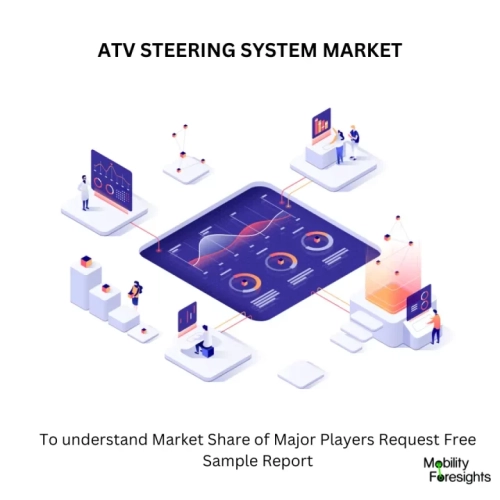
- Get in Touch with Us

Last Updated: Apr 25, 2025 | Study Period: 2024-2030
The Global ATV Steering System Market is expected to witness steady growth throughout 2024-2030, driven by several factors. The increasing popularity of off-road adventures and recreational activities is a key driver. ATVs offer a thrilling way to explore challenging terrains, and reliable steering systems are crucial for safety and maneuverability.
Furthermore, ATVs are increasingly being utilized for agricultural, forestry, mining, and construction purposes. Their adaptability and maneuverability in rough conditions make them ideal for various work applications. Here, power steering systems become especially important to reduce operator fatigue and improve efficiency.
Technological advancements in ATV design are another growth factor. Manufacturers are integrating electronic fuel injection, anti-lock braking systems, and electronic power steering for enhanced performance and user experience. These advancements make ATVs more appealing to a wider range of consumers.
Rising disposable income in emerging economies like India, China, and Brazil is another positive influence. As people in these regions have more money for leisure activities, the demand for recreational ATVs is expected to rise, propelling the growth of the ATV steering system market alongside.
However, the market also faces challenges. The high cost of power steering systems compared to traditional setups might deter some budget-conscious consumers. Additionally, safety concerns related to ATV design and potential steering system failures need to be addressed by manufacturers to ensure consumer confidence.
Looking ahead, the market for ATV steering systems is expected to benefit from continuous technological innovation. Research and development in electric and hybrid power steering systems will likely lead to more efficient and cost-effective solutions.
The growing adoption of autonomous technologies in the off-road vehicle segment presents both opportunities and challenges. While autonomous ATVs could require specialized steering systems, stringent regulations and safety considerations will need to be addressed.
Overall, the global ATV steering system market is poised for moderate growth over the next six years. Rising demand for ATVs in various applications, coupled with technological advancements, will create lucrative opportunities for market players. Addressing cost concerns and safety issues will be crucial for sustained market expansion.
An ATV (All-Terrain Vehicle) steering system is a mechanical or electronic system responsible for controlling the direction of movement of an ATV. It consists of components such as handlebars, tie rods, steering shafts, and steering knuckles, which work together to translate the driver's input into steering motion. The primary function of the ATV steering system is to provide precise and responsive control over the vehicle's direction, enhancing maneuverability across various terrains.
There are two main types of ATV steering systems: manual steering and power steering. Manual steering systems rely on the physical effort exerted by the driver to turn the handlebars and control the ATV's direction. On the other hand, power steering systems utilize hydraulic or electric assistance to reduce steering effort, providing smoother and more effortless control, especially at low speeds or when navigating through challenging terrain. While manual steering systems are simpler and more cost-effective, power steering systems offer enhanced comfort and maneuverability.
The benefits of ATV steering systems include improved handling and maneuverability, enhanced driver comfort and control, and increased safety. Power steering systems, in particular, reduce driver fatigue and muscle strain, making them especially beneficial for long rides or demanding off-road conditions.
However, there are also risks and challenges associated with ATV steering systems, such as potential malfunctions or failures leading to loss of control, particularly in rugged terrain or high-speed situations. Additionally, the complexity of power steering systems may result in higher maintenance costs and increased susceptibility to electronic or hydraulic issues. Regular inspection, maintenance, and proper training for users are essential to mitigate these risks and ensure the safe operation of ATVs.

The Global ATV Steering System Market accounted for $XX Billion in 2023 and is anticipated to reach $XX Billion by 2030, registering a CAGR of XX% from 2024 to 2030.

TechTrail Motorsintroduced theOmniGrip⢠Pro. Designed for extreme performance and precise control, the OmniGrip⢠Pro utilizes advanced sensor technology coupled with AI-driven algorithms to provide riders with unparalleled handling on any terrain. The system features a customizable steering sensitivity option, allowing riders to adjust the responsiveness to match their preferences and riding conditions. With its rugged construction and sealed electronics, the OmniGrip⢠Pro is built to withstand the harshest environments, ensuring reliability even in the most demanding off-road adventures.
Venture Dynamicsintroduced theTerrainMaster⢠Steering System, revolutionizing ATV control in challenging environments. The TerrainMaster⢠employs an innovative hydraulic-assist mechanism combined with state-of-the-art electronic stabilization, delivering enhanced stability and agility on rough terrain. Its patented Active Terrain Response technology automatically adjusts steering sensitivity and damping in real-time, optimizing performance for varying surface conditions.
OffRoad Innovationsintroduced thePrecisionSteer⢠ATV Steering System, engineered for ultimate precision and responsiveness in rugged terrain. The PrecisionSteer⢠utilizes advanced electro-hydraulic technology to provide seamless control and maneuverability, even in the most challenging environments. Equipped with an intelligent feedback system, it automatically adjusts steering resistance based on terrain conditions, ensuring optimal handling and stability. The system's compact design and plug-and-play installation make it compatible with a wide range of ATV models, offering versatility and ease of use for riders of all experience levels.
| Sl no | Topic |
| 1 | Market Segmentation |
| 2 | Scope of the Report |
| 3 | Research Methodology |
| 4 | Executive Summary |
| 5 | Introduction |
| 6 | Average B-2-B Selling Price in Past 5 Years |
| 7 | Insights from Industry Stakeholders |
| 8 | Cost Breakdown of Product Components and Average Profit Margin |
| 9 | Disruptive Innovation in the Industry |
| 10 | Technological Innovations in Global ATV Steering System Market 2024-2030 |
| 11 | Evolution of Electronic Power Steering Systems |
| 12 | Integration of Artificial Intelligence in ATV Steering Systems |
| 13 | Advancements in IoT-enabled Steering System Monitoring |
| 14 | Next-generation Sensor Technologies for Enhanced Control |
| 15 | Innovations in Drive-by-Wire Steering Systems |
| 16 | Application of Machine Learning in Steering System Optimization |
| 17 | Development of Smart Steering Assist Features |
| 18 | Integration of Augmented Reality for User Interface Enhancement |
| 19 | Adoption of Electromechanical Steering Systems |
| 20 | Implementation of Advanced Control Algorithms for Stability and Safety |
| 21 | New Product Development in the Past 12 Months |
| 22 | Market Size, Dynamics, and Forecast by Geography (2024-2030) |
| 23 | Market Size, Dynamics, and Forecast by System Type (2024-2030) |
| 24 | Market Size, Dynamics, and Forecast by Application (2024-2030) |
| 25 | Market Size, Dynamics, and Forecast by Distribution Channel (2024-2030) |
| 26 | Competitive Landscape and Market Share Analysis |
| 27 | Growth Strategy of Leading Players |
| 28 | Market Share of Vendors (2023) |
| 29 | Company Profiles |
| 30 | Unmet Needs and Opportunities for New Suppliers |
| 31 | Conclusion |